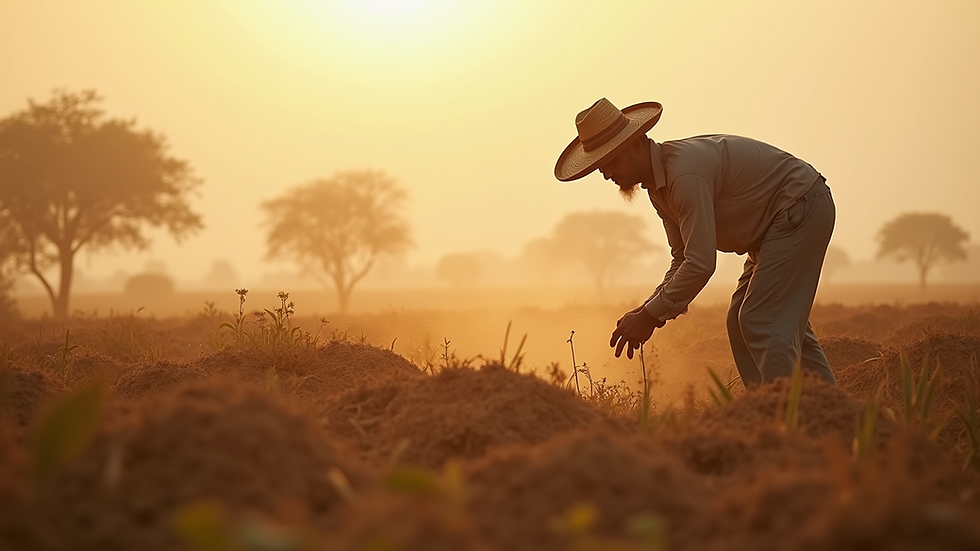Explore Land Boundaries in Rajasthan with Bhu Naksha
- Nitesh Agarwal
- Jul 26
- 4 min read
Rajasthan, known for its vibrant culture and rich history, has vast tracts of land that span across deserts, mountains, and plains. Understanding land boundaries is crucial for governance, agriculture, and development, making effective land mapping indispensable. Today we'll delve into how the Bhu Naksha platform is helping residents and stakeholders explore land boundaries in Rajasthan.
Rajasthan Land Mapping: A Necessity
Land mapping is not only about demarcating property lines; it involves a comprehensive understanding of land use, ownership, and the surrounding environment. In a state like Rajasthan, where agriculture plays a significant role, knowing the precise boundaries can make or break a farmer's livelihood.
Key Statistics on Rajasthan's Land Use
According to the Rajasthan Bureau of Economics and Statistics, over 75% of the state's land is used for agriculture. The fertile regions around Jaipur, Ajmer, and Udaipur contribute significantly to crop production, while arid regions pose specific challenges for effective land use. The lack of accurate mapping can lead to disputes, poor land management, and inefficient resource allocation.

Understanding these aspects is vital for urban planners, farmers, and policymakers alike. By utilizing modern tools like Bhu Naksha, these stakeholders can navigate the complexities of land mapping in Rajasthan more effectively.
Understanding Land Boundary Issues
Land disputes in Rajasthan are frequent, often arising from unclear demarcations. Issues can stem from improper record-keeping to disputes over inherited land. The traditional methods of establishing land boundaries can be outdated, leading to ongoing conflicts among landholders.
Pressure from the increasing population and urbanization exacerbates these challenges. As cities expand, understanding the land ownership and boundaries becomes even more crucial. Clarity in land mapping can reduce disputes significantly and streamline urban planning efforts.
The Role of Technology in Solving Land Mapping Issues
Integrating technology into land mapping is becoming vital for efficient management. Platforms like Bhu Naksha leverage digital tools to provide accurate and up-to-date information regarding land boundaries. This technological advancement allows for easier access to records that can mitigate disputes.

The benefits of using modern mapping solutions include reduced time spent on land surveying and a decrease in human error. Enhanced technology offers better precision, which translates into increased confidence among landowners and investors.
What is Bhu Naksha Indian Cadastral Mapping Solution?
Bhu Naksha is an innovative solution designed to simplify the process of land mapping in India, and particularly in Rajasthan. It provides a digital interface for both landowners and governmental authorities to visualize and manage land records. This is achieved through the use of Geographic Information System (GIS) technology, which helps in mapping areas with high accuracy.
Bhu Naksha's Key Features
User-Friendly Interface: The platform is designed to be user-centric, allowing people of varying tech-savviness to access it easily.
Real-Time Updates: Land records are updated regularly, ensuring that users have access to the most current information.
Dispute Resolution Tools: It features tools to help resolve disputes by providing clear mapping that can settle arguments over land boundaries.
Accessibility: Users can access Bhu Naksha from multiple devices, enabling farmers or landowners in rural areas to check their land status from the comfort of their homes.
Practical Applications of Bhu Naksha
For instance, a farmer can use the app to confirm the exact boundaries of their farmland before planting crops. This reduces the risk of encroachment from neighboring lands and ensures adherence to farming regulations. Similarly, builders and real estate developers benefit from precise land measurements to avoid legal tussles.

The implementation of Bhu Naksha has already shown promising results in several districts of Rajasthan. Stakeholders in agriculture, real estate, and public services are increasingly adopting this tool for efficient land management.
The Future of Land Management in Rajasthan
Looking forward, the goal is to make Bhu Naksha an integral part of land management in Rajasthan. Continued state investment in technology can yield even better results as the government seeks to modernize land governance.
Importance lies in not only having access to land records but also in promoting sustainable land use. As Rajasthan strives towards achieving its economic goals, efficient land mapping will continue to play a vital role.
Policy Recommendations for Enhanced Land Management
To maximize the benefits of Bhu Naksha and similar technologies, several policy measures can be considered:
Training Programs: Conduct training sessions for farmers and landowners on how to use digital mapping tools effectively.
Integration with Local Governance: Local bodies should take charge of updating land records to reflect real-time changes.
Awareness Campaigns: Raising awareness about the benefits of using such platforms can drive adoption.
Collaborative Efforts: Encourage collaboration between governmental authorities, NGOs, and the private sector to strengthen the technology’s implementation.
By addressing these areas, Rajasthan can ensure better management of land resources, improving the livelihoods of its residents.
Embracing the Future with Bhu Naksha
As Rajasthan continues to grow, adopting digital solutions for land mapping is not just wise but essential. The Bhu Naksha platform stands out as a crucial tool for demystifying land boundaries, fostering transparency, and aiding in effective land management.
Through this digital innovation, stakeholders in Rajasthan can navigate the complexities of land ownership with newfound ease and confidence. As the state marches towards an economically robust future, tools like Bhu Naksha will be instrumental in shaping the landscape of land management.



Comments